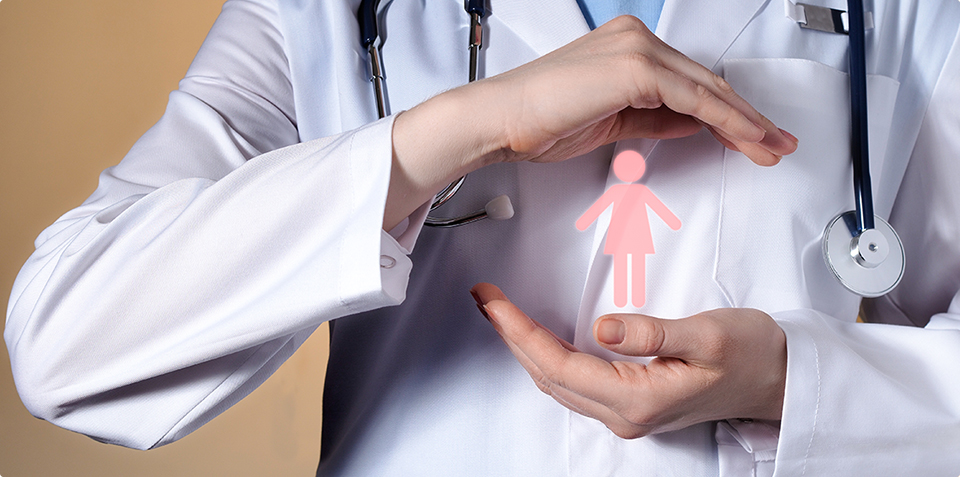Gynecology

Gynecology at Hayat Clinic provides our female patients with the most comfortable conditions for a comprehensive check-up. A comprehensive gynecological check-up is an important measure to prevent the diseases of the reproductive system. It makes it possible to detect infectious diseases, neoplasms and other pathologies at the initial stages. The earlier treatment is started, the less time it will take, and the lower risk of complications is. It is recommended to undergo an examination every year.
Gynecological check-up
To save money and time of our female patients, Hayat Clinic has developed the special check-up programs for women under and over 40.
What are the parts of the comprehensive gynecological examination?
The procedure includes a specialised medical consultation, a standard examination of the genitals and taking a smear for subsequent analysis of the vaginal microflora and detection of STIs. The risk of many infectious diseases lies in the fact that they stay asymptomatic for a long time. Statistics show that 8-10% of women undergoing an annual preventive examination find various gynecological pathologies that do not manifest themselves in any way. For example, ureaplasmosis, mycoplasmosis, and chlamydia may not cause any discomfort, and a woman finds out about them only when faced with complications (infertility, miscarriage).
Laboratory tests
They show the state of the epithelial tissue of the vagina and cervix, the ratio of healthy, pathogenic, and opportunistic pathogenic microflora, the presence of STI pathogens. A full-fledged diagnosis of gynecological diseases is impossible without laboratory tests. For the test, the physician takes a smear from the vagina, as well as scrape of the tissue from the cervix and cervical canal for biopsy, if malignant neoplasms are suspected. If the suspected pathology is confirmed, additional extended examinations may be required.
What tests do you need to take?
As part of the preventive examination, the following tests are usually run:
- smear microscopy;
- bacterial seeding;
- cytological studies;
- PCR method.
The level of cancer-specific markers is checked for a comprehensive assessment of existing neoplasms. When symptoms of hormonal imbalance, infertility or tumors appear, the endocrine profile is evaluated. The specific list of tests depends on the results of the examination and the patient's medical history. The gynecologist prescribes studies based on the available data and symptoms of the disease.
Instrumental diagnosis
It is carried out to identify anatomical and physiological disorders. The physician prescribes an instrumental diagnosis based on the results of the examination in case of suspected pathology.
Ultrasound
Ultrasound examination is the most common method of diagnosing gynecological diseases. The procedure is safe, cause no discomfort, and has no contraindications and frequency restrictions. Ultrasound reveals a wide range of pathologies and allows you to see the features of the reproductive organs, their size, placement, blood supply, tissue uniformity, the presence of neoplasms, as well as pregnancy. Depending on the indications, transabdominal and transvaginal ultrasounds are performed. Oftentimes both options are performed within the same procedure.
Video colposcopy
The method makes it possible to differentiate pathologies based on various changes in the vaginal mucosa and the cervical canal. During the procedure, the competent specialist takes the tissue samples for histological examination. Video colposcopy is performed using an optical device with a high-resolution camera. The enlarged image is displayed on the monitor in real time.
Hysteroscopy
It shows the overall state of the cervical canal, uterus, orifices of fallopian tubes, and endometrium. The hysteroscope allows not only to diagnose, but also to simultaneously perform minimally invasive surgical operations, for example, removal of polyps and adhesions.
Hysterosalpingography. A method of X-ray examination to assess the general state of the fallopian tubes and myometrium layers, as well as the diagnosis of anatomical pathologies. In our clinic, the procedure is performed on a latest digital device providing the minimal radiation exposure on the body.
How to prepare for the examination?
The preventive examination is fast. There is no need for special preparation. Standard intimate hygiene before the examination is sufficient. However, refrain from douching, using vaginal candles and other medicine affecting the microflora before the examination for an accurate diagnosis. If an ultrasound is prescribed, it is recommended to refrain from products provoking excessive gas the day before the procedure, including heavy high-fat food, legumes, rye bread, fresh fruits and vegetables. There is no restriction for pure still water.





